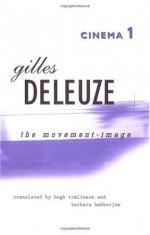|
This section contains 650 words (approx. 2 pages at 400 words per page) |

|
The Crisis of the Action-Image Summary and Analysis
Peirce's "thirdness" and mental relations distinguish affection that he calls "Firstness" from action that he calls "Secondness" to which he adds an image he terms "mental" and calls "Thirdness." This term of "Thirdness" refers to a second term through another term, as signification, law or relation. Peirce claims there is nothing beyond thirdness because everything can be reduced to combinations of 1, 2, or 3. This is most clearly represented in relation since it is external to its terms. This group constitutes the whole where each in turn affirms itself in itself not as in a series, somewhat similar to dialectic as interpreted. As mental image, "Thirdness" exists as an image of things that have an existence outside thought, like objects of perception exist outside perception. In burlesque for example, 1 is represented by Langdon, 2 by Laurel...
(read more from the The Crisis of the Action-Image Summary)
|
This section contains 650 words (approx. 2 pages at 400 words per page) |

|




